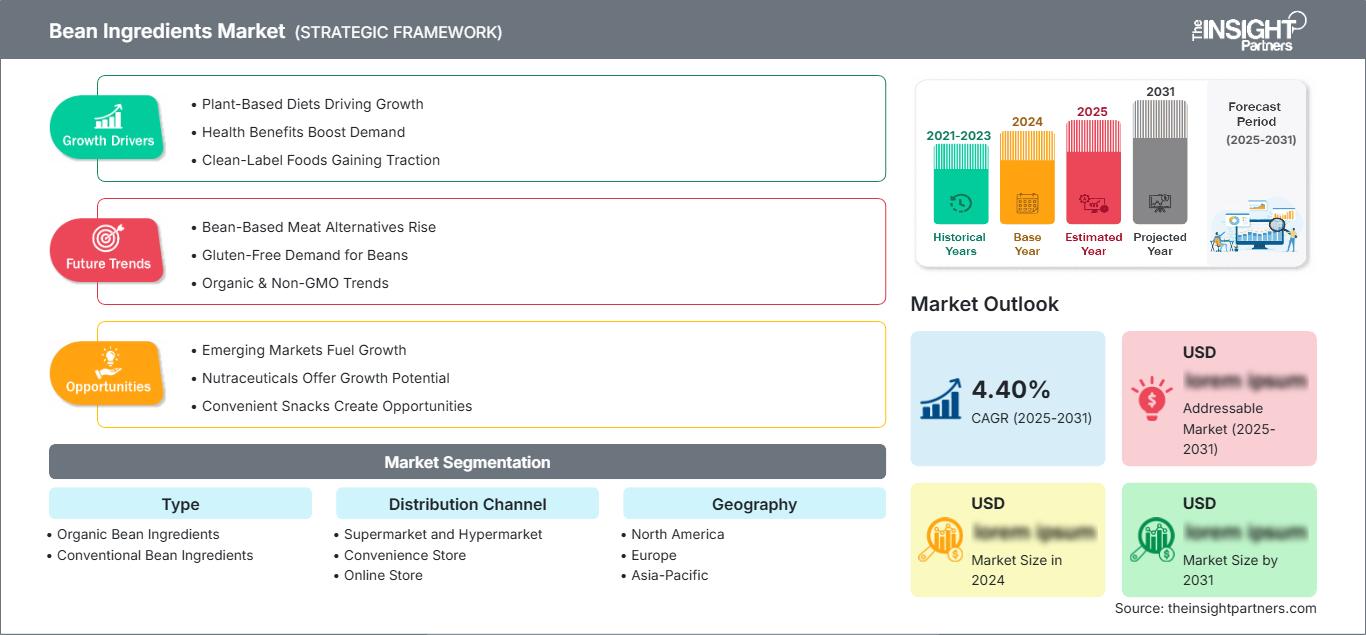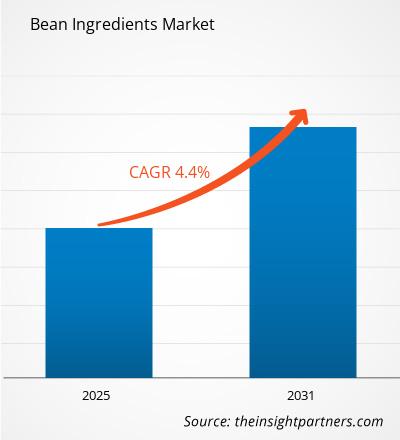页面已更新 :
Jan 2025
预计豆类配料市场在 2025 年至 2031 年期间的复合年增长率为 4.40%,市场规模将从 2024 年的 XX 百万美元扩大到 2031 年的 XX 百万美元。
豆类配料市场报告涵盖按类型(有机豆类配料、传统豆类配料)和分销渠道(超市和大卖场、便利店、网上商店、其他)进行的分析。全球分析进一步细分为区域和主要国家。该报告以美元为单位提供了上述分析和细分的价值。
报告目的
Insight Partners 发布的《豆类配料市场》报告旨在描述当前的格局和未来的增长、主要驱动因素、挑战和机遇。这将为各种业务利益相关者提供见解,例如:
- 技术提供商/制造商:了解不断变化的市场动态并了解潜在的增长机会,使他们能够做出明智的战略决策。
- 投资者:对市场增长率、市场财务预测和整个价值链中存在的机会进行全面的趋势分析。
- 监管机构:规范市场政策和警察活动,旨在最大限度地减少滥用,维护投资者的信任和信心,并维护市场的完整性和稳定性。
豆类配料市场细分类型
- 有机豆类配料
- 传统豆类配料
分销渠道
- 超市和大卖场
- 便利店
- 网上商店
自定义此报告以满足您的要求
您将免费获得任何报告的定制,包括本报告的部分内容,或国家级分析、Excel 数据包,以及为初创企业和大学提供超值优惠和折扣
豆类原料市场: 战略洞察

- 获取本报告的主要市场趋势。这个免费样本将包括数据分析,从市场趋势到估计和预测。
豆类配料市场增长动力
- 植物性饮食推动增长:豆类配料市场的增长主要归因于人们转向植物性饮食,这增加了对豆类配料作为蛋白质来源的需求。豆类富含蛋白质、纤维和其他营养素,因此常用于纯素食和素食产品。市场报告称,这种不断增长的需求扩大了豆类配料市场的规模,因为人们想要可持续的蛋白质选择。根据 PEST 分析,环境效益和健康趋势是最重要的驱动力,而从竞争分析来看,人们注意到与植物性产品相关的创新正在增长。
- 健康益处刺激需求:对豆类功能性食品的需求增加是由于其营养成分包括高纤维和维生素以及低脂肪含量。消费者的健康意识水平必然会提高,从而导致他们对更多天然成分的需求更高,这些成分可以构成均衡饮食和健康的基础。市场分析显示,市场规模的扩张源于健康益处,其中豆类成分拥有庞大的受众群体。从竞争分析来看,生产营养丰富、注重健康的产品的公司将占据有利地位,抢占全球豆类成分市场的份额。
- 清洁标签食品日益流行:清洁标签食品和饮料已成为豆类成分市场的重要驱动力。由于豆类被认为是天然且加工程度最低的成分,它们支持与透明度和可持续性相关的市场方向。市场分析将确定清洁标签需求是市场及其增长背后的驱动力。 PEST 分析将指出一个良好的监管框架,以便更清晰地标记,因此全球市场将通过制造商使用豆类成分得到进一步推动,因为消费者对更天然、更简单或更少化学成分的偏好将影响制造商朝这个方向推出产品。
豆类成分市场未来趋势
- 豆类肉类替代品兴起:豆类已成为用于肉类替代品的流行蛋白质成分,因为它们符合豆类成分市场首选植物性食品的动态。主要参与者正在开发创新的新型豆类肉类替代品,以满足寻求可持续蛋白质替代来源的消费者日益增长的需求。对豆类的 SWOT 分析表明,这些食品具有灵活性和良好的营养成分,可以维持产品开发,从而增强市场战略。在该地区,由于对环保蛋白质来源的持续需求,预计增长率将大幅上升。
- 豆类的无麸质需求:随着无麸质食品市场的日益增长,新的趋势正在形成,豆类成分,特别是鹰嘴豆和扁豆粉,被引入到许多产品中。各企业正抓住这一良机,根据市场推荐,通过健康和膳食均衡的选项来增强其产品组合。因此,根据对无麸质营养丰富的替代品的需求预测趋势分析,预计这一市场将继续增长。
- 有机和非转基因趋势:关键在于有机和非转基因豆类成分、消费者对食品采购的高度认知以及对食品质量的重视。各大品牌已经开始调整其市场策略,推出以豆类为基础的有机产品,以满足以健康为导向的市场需求。基于这种方法的SWOT分析表明,它将有利于提升品牌忠诚度,同时满足透明度需求偏好的要求。由于对此类产品的需求增强,按细分市场估算的市场规模在这些类型产品稳步增长的情况下有所体现。
豆类配料市场机遇
- 新兴市场推动增长:亚太地区和拉丁美洲为豆类配料市场提供了巨大的增长机会。可支配收入的提高和对健康食品的兴趣增加了对豆类产品的需求。市场概览报告称,这些地区尚未被开发,公司可以通过专注于这些地区来抢占市场份额。北美市场稳定,新兴市场的扩张支撑着全球行业格局
- 营养保健品提供增长潜力:对功能性和营养保健品的高需求正在成为豆类配料市场的潜在机会。豆类富含纤维和蛋白质,并具有抗氧化剂,这使得基于健康益处的产品开发成为可能。市场概览表明,进入营养保健应用领域的公司享有额外的优势,这种优势在北美和欧洲近年来变得更加明显。增长机会将与健康食品日益增长的需求保持一致,从而提升品牌在行业格局中的地位。
- 方便零食创造机遇:健康便捷的零食在豆类配料市场以及零食和即食食品类别的各个细分领域都呈现出强劲的增长机会。如今,豆类也被用于制作零食棒、薯片以及其他相关产品,这些产品吸引了注重营养、寻求便捷选择的消费者。豆类配料市场份额数据表明,通过瞄准零食类别,市场将拥有巨大的增长机会。北美和欧洲引领着这一趋势,豆类配料市场概况表明,随着消费者口味的变化,市场将继续保持增长机会。
豆类食材市场
The Insight Partners 的分析师已详尽阐述了预测期内影响豆类配料市场的区域趋势和因素。本节还讨论了北美、欧洲、亚太地区、中东和非洲以及南美和中美洲的豆类配料市场细分和地域分布。
豆类成分市场报告范围
| 报告属性 | 细节 |
|---|---|
| 市场规模 2024 | US$ XX million |
| 市场规模 2031 | US$ XX Million |
| 全球复合年增长率 (2025 - 2031) | 4.40% |
| 历史数据 | 2021-2023 |
| 预测期 | 2025-2031 |
| 涵盖的领域 |
By 类型
|
| 覆盖地区和国家 | 北美
|
| 市场领导者和主要公司简介 |
|
豆类成分市场参与者密度:了解其对业务动态的影响
豆类配料市场正在快速增长,这得益于终端用户需求的不断增长,而这些需求的驱动因素包括消费者偏好的不断变化、技术进步以及对产品优势的认知度不断提高。随着需求的增长,企业正在扩展产品线,不断创新以满足消费者需求,并抓住新兴趋势,从而进一步推动市场增长。

- 获取 豆类原料市场 主要参与者概述
主要卖点
- 全面覆盖:本报告全面涵盖了对豆类成分市场的产品、服务、类型和最终用户的分析,提供了整体格局。
- 专家分析:本报告基于对行业专家和分析师的深入了解而编写。
- 最新信息:由于涵盖了最新信息和数据趋势,本报告确保了业务相关性。
- 定制选项:此报告可以根据特定客户要求进行定制,并恰如其分地适应业务策略。
因此,豆类成分市场研究报告可以帮助引领解读和理解行业情景和增长前景的线索。尽管可能存在一些合理的担忧,但本报告的总体优势往往大于劣势。
- 历史分析(2 年)、基准年、预测(7 年)及复合年增长率
- PEST和SWOT分析
- 市场规模、价值/数量 - 全球、区域、国家
- 行业和竞争格局
- Excel 数据集
近期报告
客户评价
购买理由
- 明智的决策
- 了解市场动态
- 竞争分析
- 客户洞察
- 市场预测
- 风险规避
- 战略规划
- 投资论证
- 识别新兴市场
- 优化营销策略
- 提升运营效率
- 顺应监管趋势
我们的客户































87-673-9708

ISO 9001:2015



 获取免费样品 - 豆类原料市场
获取免费样品 - 豆类原料市场